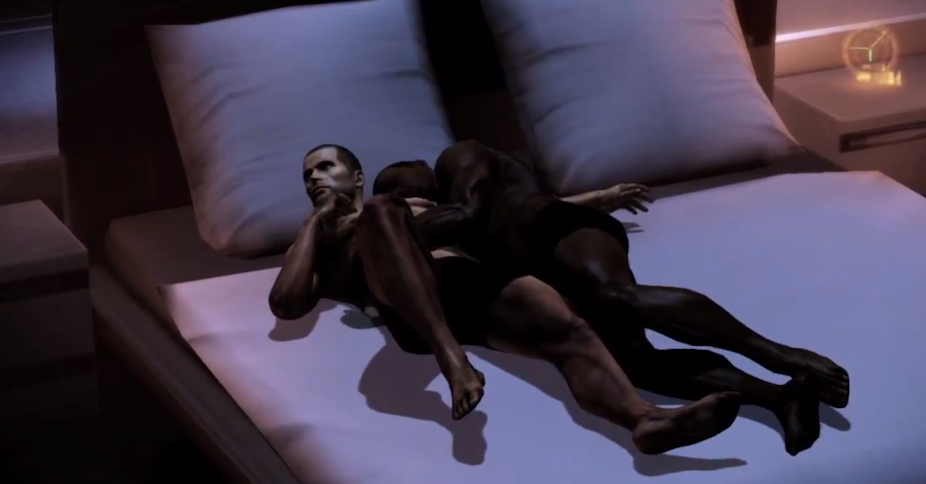It may seem surprising, but the number of queer characters in videogames has increased dramatically over the last decade.
A key influence of this is “media convergence”, that is, the flow of subject matter across media platforms and the migratory nature of media consumers: people who play games are also movie-goers and television-watchers. They understand cultural codes in videogames because they have already seen it used in film.
This convergence has lead to a blurring of the boundaries between film and videogames. We now have films that mirror videogame aesthetics, such as the layered dreams in Inception or the levels in Sucker Punch.
In return, we have videogames increasingly becoming narrative driven and using a cinematic aesthetic. The cinematography, editing and aural cues of highly stylised games such as the Uncharted series or Heavy Rain all rely on cultural codes set by the movie industry.
The evolution of Birdo
Queer videogame characters have evolved from being confined to rarely seen supporting roles, to becoming playable protagonists.
Perhaps one of the earliest queer videogame characters was Birdo in Nintendo’s Super Mario Bros. 2 (1988). The instruction manual for the Japanese original stated:
“Birdo thinks he is a girl and likes to be called Birdetta. He likes to wear a bow on his head and shoot eggs from his mouth.”
Unfortunately, Nintendo’s in-house censorship of the time forced subsequent editions of the instruction manual to erase Birdo’s transgender identity.
Nintendo brought back Birdo for Mario Tennis on the Nintendo 64 as well as Mario Kart Wii and Super Smash Brothers for the Wii console. Disappointingly, however, the creators of Super Smash Brothers made a point of referring her to as “it” which, while acknowledging her alternative gender identity, is frustratingly transphobic.
All subsequent appearances of her character, such as in Super Smash Brothers Brawl and in the Mario Party series, have since listed her as female, which is a satisfying improvement from “it” or “trying to be.”
A brief history of queer cinema
This early queer representation mirrors the development of lesbian, gay, bisexual, and transgender (LGBT) characters in cinema.
The Hays censorship code during the golden age of Hollywood forced films to only hint at a character’s sexuality. We had the asexual pansy in Our Betters and The Gay Divorcee, and the butch villainous woman in Dracula’s Daughter and Caged.
These stereotypes of alternative gender representations were either to be laughed at or feared.
Of course, this all changed with the increase in independent film production as the 20th century progressed and the golden age of Hollywood drew to a close. LGBT filmmakers increasingly began to tell their own stories.
We had filmmakers such as Kenneth Anger and Jack Smith making experimental underground films and initial attempts to woo a gay and lesbian market with Desert Hearts, Making Love, The Boys in the Band and My Beautiful Laundrette.
It wasn’t until the success of the queer new wave of cinema in the early 90s that distributors began to take notice of the profitability behind this pink dollar. Now we have Wolfe distribution and TLA Video, among many more, which have a specific focus on distributing LGBT-related films in America and abroad.
‘Gayming’ the market
It is this acknowledgement of a niche market that we are now starting to see in videogame culture.
There has long been a false assumption that the driving force of the videogame market consists of straight, teenage boys playing in their bedrooms. This was drastically proven false, however, with the release of The Sims in 2000, which is now one of the most successful videogame franchises of all time.
The Sims (and Sims 2 and Sims 3) are strategic life simulation games where the player creates virtual people and aims to fulfil their life’s goals and daily needs. A significant aspect of this game is forming romantic connections (and “woo hoo-ing” in bed).
Players were free to form relationships with “sims” of their choice regardless of gender. Sims 3 was a cultural trailblazer by adapting to the contemporary political climate and allowing gay marriage within the game. Gay marriage is also allowed in other RPG games such as the Fable trilogy and The Elder Scrolls V: Skyrim.
Recent success Mass Effect 3 also allows for the protagonist to form gay romantic connections. This allows more choice for the “gaymer” in an originally heteronormative environment.
This is all a part of allowing the player a full range of character choices. It is also an acknowledgement of the changing nature of the videogame playing market.
The road ahead
While videogame content still has significant mileage to cover with regard to identity politics (an examination of the misogynistic portrayal of women in videogame culture is far beyond the scope of this article), we are indeed beginning to see pleasing development of queer characters in videogames.
We are seeing an increasing number of independently released games and further choice allowed for players. This choice is a significant acknowledgement that the market of videogames is indeed a heterogeneous array of identities.

